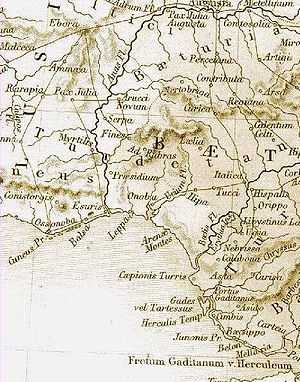Cynetes
The Cynetes or Conii were one of the pre-Roman peoples of the Iberian Peninsula, living in today's Algarve and Lower Alentejo regions of southern Portugal before the 6th century BCE (in what was to become the southern part of the Roman province of Lusitania).
They are often mentioned in the ancient sources under various designations, mostly Greek or Latin derivatives of their two tribal names: ‘Cynetas’/’Cynetum’;[2] ‘Kunetes’, ‘Kunetas’, and ‘Kunesioi'[3] or ‘Cuneus’,[4] followed by ‘Konioi’,[5] ‘Kouneon’[6] and ‘Kouneous’/‘Kouneoi’.[7]
Inscriptions
Inscriptions in the Tartessian language have been found in the area, in a variety often referred to as Southwest Paleohispanic script.[8][9] The name Conii, found in Strabo, seems to have been identical with the Cynesii, who were mentioned by Herodotus as the westernmost dwellers of Europe and distinguished by him from the Celts.[10]
Main city

The main city of the country of the Conii was Conistorgis, according to Strabo, who considered the region Celtic.[11] In the local language Conistorgis probably means "City of the Conii".
The city was destroyed by the Lusitanians, during the Lusitanian War against Rome, because the Conii had become allied with the Romans during the Roman conquest of the Iberian Peninsula (called Hispania by the Romans). Its precise site has not been rediscovered. Some authors[12] suggest that Pax Julia might have been founded over the ruins of Conistorgis.
See also
- History of Portugal
- Prehistoric Iberia
- Cyneticum
- Timeline of Portuguese history
- Sefes
- Celtici
- "Tartessian" language (Southwestern or "South-Lusitanian" language)
- Pre-Roman peoples of the Iberian Peninsula
Notes
- ↑ Arkeotavira.com map
- ↑ Avienus, Ora Marítima, 200, 205, 223
- ↑ Herodoros of Heracleia, Fragments
- ↑ Pliny the Elder, Natural History, V, 41, 145
- ↑ Polybius, Istorion, 10: 7, 5
- ↑ Strabo, Geographikon, 3, 1, 4
- ↑ Appian, Iberiké, 10: 75
- ↑ Koch, John T (2010). Celtic from the West Chapter 9: Paradigm Shift? Interpreting Tartessian as Celtic. Oxbow Books, Oxford, UK. p. 187. ISBN 978-1-84217-410-4.
- ↑ Koch, John T (2011). Tartessian 2: The Inscription of Mesas do Castelinho ro and the Verbal Complex. Preliminaries to Historical Phonology. Oxbow Books, Oxford, UK. pp. 4–5. ISBN 978-1-907029-07-3.
- ↑ Herodotus writes "now the Celtae dwell beyond the pillars of Hercules, being neighbours of the Cynesii, who are the westernmost of all nations inhabiting Europe" (Herodotus, II, 33). In another reference noting the Celts again in the extreme west, he refers to their neighbors the Cynetes: "...the Celts, who, save only the Cynetes, are the most westerly dwellers in Europe." (IV, 49).
- ↑ "In the country of the Celti, Conistorgis is the best known city" (Strabo, III, 2, 2).
- ↑ Ensaio Monográfico de Beja, 1973, Manuel Joaquim Delgado e Beja XX Séculos de História de Uma Cidade,
References
- Mattoso, José (dir.), História de Portugal. Primeiro Volume: Antes de Portugal, Lisboa, Círculo de Leitores, 1992. (in Portuguese)
- Berrocal-Rangel, Luis (2005). "The Celts of the Southwestern Iberian Peninsula". e-Keltoi: Journal of Interdisciplinary Celtic Studies 6: 481–96.
- Júdice Gamito, Teresa (2005). "The Celts in Portugal". e-Keltoi: Journal of Interdisciplinary Celtic Studies 6: 571–605.
- Strabo, Geographika, III, 2, 2.
- Muñoz, Mauricio Pasto: Viriato, A Luta pela Liberdade, Ésquilo, 2003 (third edition; ISBN 972-8605-23-4).